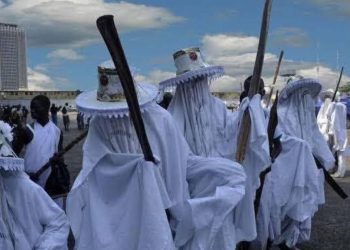How many Nigerian bridges do you know? Have you ever wanted to explore these architectural marvels? Then you are at the right spot. Keep reading to know more about Nigerian bridges and discover the longest bridge in Nigeria.
Nigeria is a land filled with many infrastructural designs. From the skyscrapers of the island to the edifices on its mainland, the nation’s infrastructure has struck wonder in many individuals.
Today, we look at another exciting expression of Nigeria’s infrastructure, bridges. Due to the nation’s connection to the Atlantic Ocean and its widespread land mass of about 923,768 km2, there are many extensive bridge structures in Nigeria.
The Top 5 Nigerian Bridges
There are several iconic Nigerian Bridges. Some of them are in Africa’s most populous city, Lagos while others are in the obscure regions of Nigeria. The location of the bridges, length and other information will be shared in today’s post.
Third Mainland Bridge- 11,800m
The third mainland Bridge is Nigeria’s longest bridge. Located in Lagos, it has been a Nigerian landmark since its construction in 1990. The Third Mainland Bridge emerged as a response to the burgeoning population and increasing traffic congestion in Lagos. President Shehu Shagari commissioned it in 1980 and completed by General Ibrahim Babangida in 1990.
Julius Berger Nigeria PLC was in charge of this landmark bridge project. Engineers and architects collaborated to overcome the challenges posed by the vast lagoon and soft soil. The result? A structure that not only defied engineering odds but also became a symbol of modernization.
Third Mainland Bridge serves as a vital lifeline, connecting the bustling mainland to the vibrant islands of Lagos. Its strategic location facilitates the flow of people and goods, contributing to the Lagos commercial hub.
From its inception to the present day, the bridge remains a silent witness to several historical moments in Lagos. It serves as a neutral ground connecting several people at different stages in life and from unique fields. The bridge, with its intricate steel cables and massive pillars, is an engineering masterpiece, forever etched into the soul of Nigeria’s bustling megacity.
Loko-oweto Bridge- 1,835m
The Loko-oweto Bridge is a testament to the skillfulness of Nigerian engineering. Nestled over the Benue River, the Loko-Oweto Bridge stands as a symbol of progress and connectivity, connecting Venue and Nasarawa states.
Spanning over 1,835m, the Loko-oweto Bridge was constructed to establish a stable connection between the two states. The Bridge was commissioned under President Buhari’s administration and opened in early 2023. It consists of 2 bridges that have a total coverage of 2.2km and other link roads between Benue and Nasarawa.
The Nigerian Ministry of Works and Housing in conjunction with Reynolds Construction Company Nigeria,( a subsidiary of SBI Holdings International AG) built the dual bridge linking Loko (in Nasarawa state) to Oweto( in Benue state). The construction of the bridge has contributed to the economic growth and cultural integration of the regions around it.
Second Niger Bridge- 1,600m
The excitement surrounding the construction of the second Niger bridge from Delta State to Anambra State contributed to the obscurity of the Loko-oweto Bridge.
Did you know that General Ibrahim Babangida challenged Nigerian Engineers to design the Second Niger Bridge in 1987? The Nigerian Society of Engineers rose to the challenge but subsequent government administrations did not implement the design. Eventually, the wishes of the people became a reality.
Stretching over approximately 1.6 kilometres, the Second Niger Bridge stands as a testament to design ingenuity. Engineers meticulously crafted a structure that not only spans the wide expanse of the Niger River but also complements the natural beauty of its surroundings. The bridge is a harmonious blend of form and function.
The Second Niger Bridge holds immense strategic significance. It acts as a vital link between Anambra and Delta, alleviating traffic congestion on the existing bridge and facilitating smoother transportation. This strategic positioning enhances regional connectivity and accelerates economic activities in the area.
This innovative bridge incorporates local design and art into its structure- thereby celebrating the rich culture of the Anambra and Delta regions. The second Niger River was commissioned in 2018 and inaugurated in May 2023 by Julius Berger Nigeria PLC.
The bridge was opened on Dec 15, 2022, to reduce traffic congestion during the festive season. However, May 2023 is its official completion date when all linking roads are complete.
Like its counterpart on the Benue River, the second Niger bridge was started and completed under President Buhari’s administration. The Nigerian Ministry of Works and Housing reported a cost of about N336 billion for this engineering brilliance.
River Niger Bridge -1,104m
The original River Niger or Onitsha Bridge was built in 1965 as a connecting road between Delta State and Anambra State. At the time, the country was experiencing a period of economic expansion, and the bridge became a symbol of progress—a tangible link between regions.
The bridge was built by French construction company, Dumez. It spans an estimated 1.4 kilometres, with multiple spans and impressive architectural features. Its foundations delve deep into the riverbed, ensuring stability against the strong currents of the Niger.
Onitsha, known as the “trading hub” of West Africa, stands as a bustling economic centre. The bridge acts as a channel for the movement of goods and people. Hence, fostering trade and economic activities between Onitsha and Asaba. The efficient transportation of goods across the bridge has boosted local economies and also strengthened Nigeria’s position in the region among neighbouring countries.
The River Niger Bridge acts as a meeting place of traditions, languages, and customs, fostering a sense of unity among the people. The bridge is not just a physical connection but a cultural crossroads where stories, traditions, and experiences converge.
The Ikoyi Bridge- 1,360m
Did you know Mark Zuckerberg jogged on the Ikoyi Lekki bridge when he visited Lagos? The bridge is a hotspot for morning joggers and runners living within the Ikoyi-Lekki axis.
It features sleek lines, a cable-stayed structure, and illuminated cables that come to life in the evening, creating a spectacle against the Lagos skyline. It seamlessly blends functionality with aesthetics, making it not just a means of crossing but a visual delight for both locals and visitors.
The bridge which was completed in 2013, serves as a vital link, facilitating smoother and more efficient movement between Ikoyi and the rest of Lagos. Its strategic location contributes significantly to decongesting key traffic points in the city.




![Terrifying Uber Ride: Lady Panics After Discovering Broken Door Lock Mid-Trip [VIDEO]](https://bestlagos.ng/wp-content/uploads/2025/12/White-Modern-Fashion-Trends-Photo-Collage_20251211_085520_0000-350x250.jpg)


















